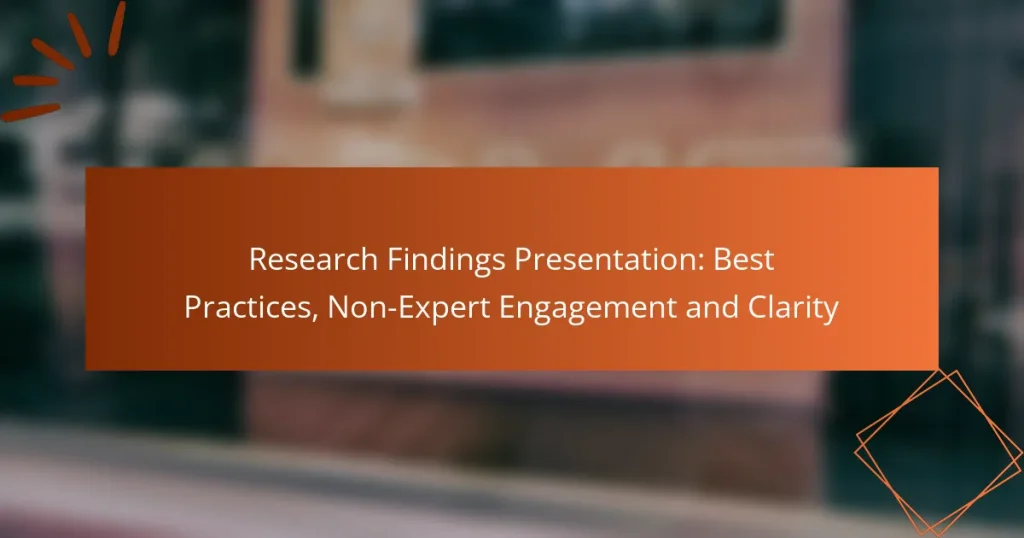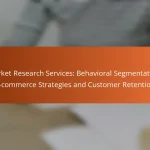Presenting research findings effectively requires clear visuals, structured narratives, and engaging storytelling to make complex information accessible to non-experts. By focusing on relatable content and encouraging audience interaction, presenters can foster a more inclusive atmosphere that enhances understanding. Utilizing dynamic delivery methods and visual data representations further improves clarity and retention, ensuring that key insights resonate with all attendees.

What are the best practices for presenting research findings?
Best practices for presenting research findings include using clear visuals, structuring the narrative effectively, and engaging the audience through storytelling. These methods enhance understanding and retention, making complex information accessible to non-experts.
Clear visual aids
Clear visual aids are essential for conveying research findings effectively. Use charts, graphs, and infographics to illustrate key points and trends, ensuring they are easy to read and interpret. Aim for simplicity; avoid clutter that can confuse the audience.
For instance, a bar graph can effectively compare data sets, while a pie chart can show proportions. Always label visuals clearly and provide context to enhance comprehension.
Structured narrative
A structured narrative helps guide the audience through the research findings logically. Start with an introduction that outlines the purpose and significance of the research, followed by a clear progression of ideas. Each section should build on the previous one, leading to a coherent conclusion.
Consider using a framework like the “Problem-Solution-Outcome” model to organize your presentation. This approach clarifies the research’s relevance and implications, making it easier for the audience to follow.
Engaging storytelling
Engaging storytelling can make research findings more relatable and memorable. Use anecdotes, case studies, or real-world examples to illustrate key points and connect with the audience emotionally. This approach can help demystify complex concepts.
For example, sharing a personal story related to the research can draw in listeners and make the findings feel more applicable to their lives. Aim to create a narrative arc that captivates your audience from start to finish.
Audience-tailored content
Tailoring content to the audience’s knowledge level and interests is crucial for effective presentations. Understand who your audience is and adjust your language, examples, and depth of detail accordingly. Avoid jargon unless it is well understood by the audience.
For instance, when presenting to a general audience, focus on the implications of the research rather than technical details. This approach ensures that your message resonates and is easily understood.
Effective data visualization
Effective data visualization transforms complex data into understandable visuals. Use appropriate types of charts and graphs to represent different kinds of data, ensuring clarity and accuracy. Stick to a consistent color scheme and design style to enhance visual coherence.
Incorporate interactive elements, like clickable graphs or dynamic dashboards, when possible. These tools can engage the audience further and allow them to explore the data at their own pace, fostering a deeper understanding of the findings.
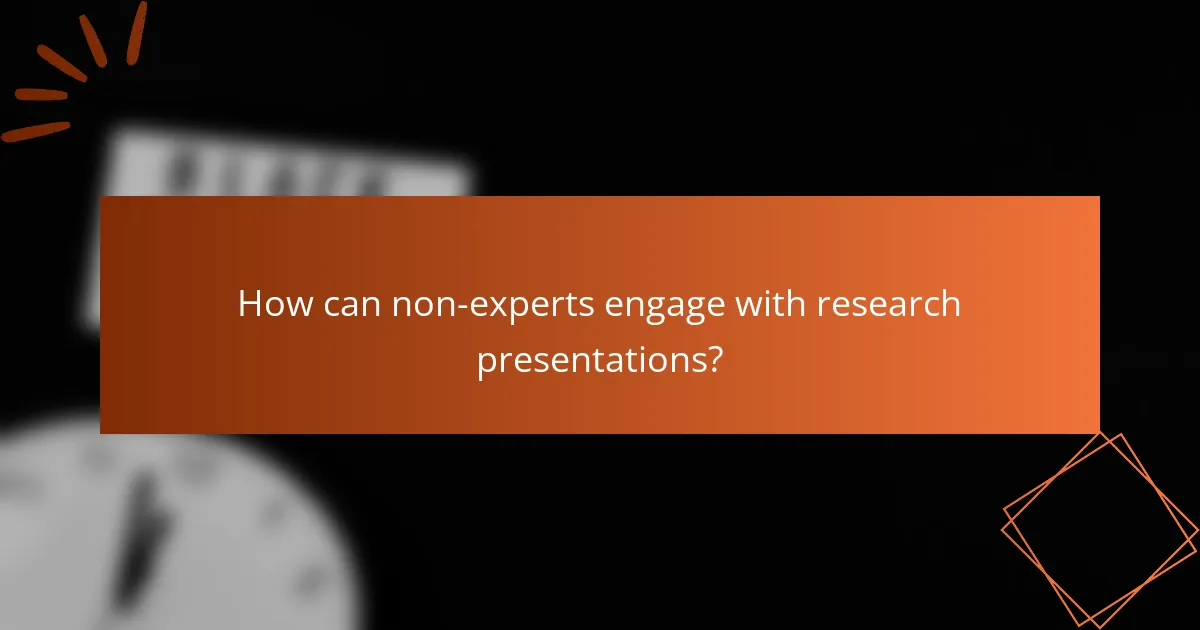
How can non-experts engage with research presentations?
Non-experts can engage with research presentations by focusing on relatable content, asking questions, and utilizing clear visuals. These strategies help demystify complex topics and foster a more inclusive atmosphere for understanding research findings.
Use of relatable examples
Relatable examples bridge the gap between complex research and everyday experiences. Presenters should use analogies or case studies that resonate with the audience’s background, making the information more accessible and memorable.
For instance, if discussing climate change, referencing local weather patterns or community impacts can help illustrate the broader implications of the research. This approach encourages audience members to connect personally with the material.
Interactive Q&A sessions
Interactive Q&A sessions allow non-experts to clarify doubts and engage directly with the research. Presenters should allocate time for questions, encouraging audience participation to foster a two-way dialogue.
To enhance engagement, consider using tools like live polls or question submission platforms. This can help gather questions anonymously, making it easier for attendees to participate without hesitation.
Simplified language
Simplified language is crucial for making research findings understandable to non-experts. Avoid jargon and technical terms unless they are clearly defined, as this can alienate the audience.
Using straightforward vocabulary and short sentences can significantly improve comprehension. For example, instead of saying “utilize,” simply say “use.” This small change can make a big difference in clarity.
Visual summaries
Visual summaries enhance understanding by presenting information in a digestible format. Charts, infographics, and slides can effectively convey key points and data without overwhelming the audience.
When creating visuals, focus on clarity and relevance. Use contrasting colors and clear labels to highlight important information, ensuring that even those unfamiliar with the topic can grasp the main ideas quickly.
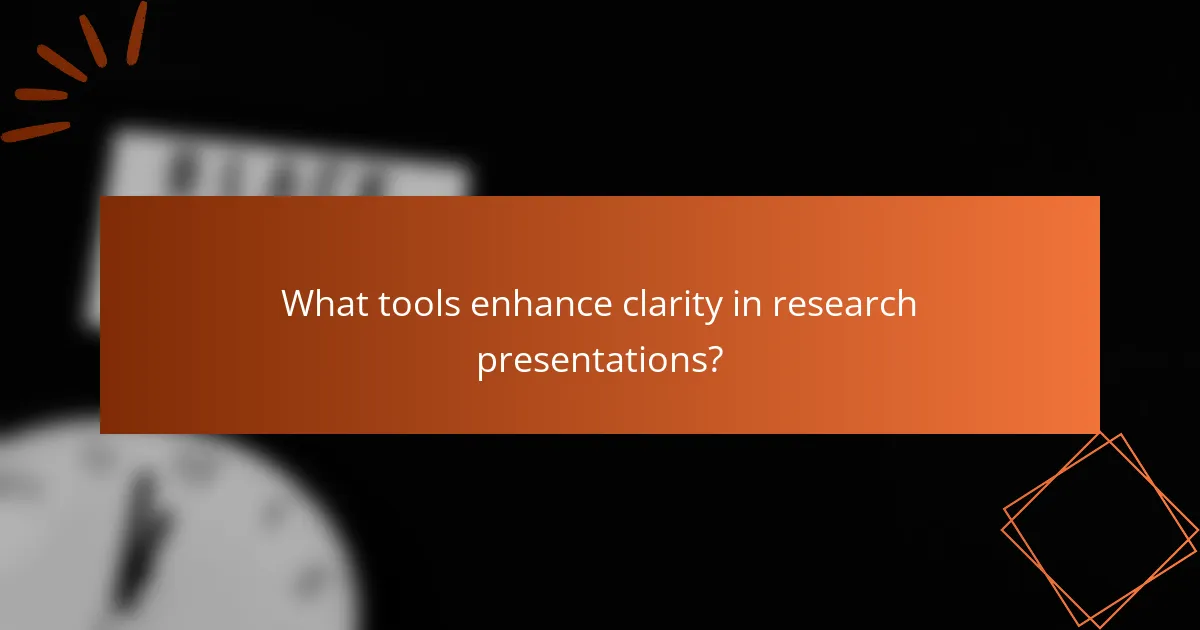
What tools enhance clarity in research presentations?
Effective research presentations benefit from tools that improve clarity and engagement. Utilizing structured formats, visual data representations, and dynamic delivery methods can significantly enhance audience understanding and retention.
PowerPoint for structured slides
PowerPoint is a widely used tool that allows presenters to create structured slides, making it easier to organize information logically. Each slide can focus on a single idea, supported by bullet points, images, and charts, which helps maintain audience attention.
When using PowerPoint, aim for a simple design with consistent fonts and colors. Limit the amount of text per slide to avoid overwhelming your audience. A good rule of thumb is to use no more than six bullet points per slide, with each point containing no more than six words.
Tableau for data visualization
Tableau excels in transforming complex data sets into clear, interactive visualizations. This tool allows researchers to create graphs, charts, and dashboards that make data more accessible and understandable for non-expert audiences.
To effectively use Tableau, focus on the story your data tells. Choose the right type of visualization for your data—bar charts for comparisons, line graphs for trends, and scatter plots for relationships. Keep visualizations simple and avoid clutter to enhance clarity.
Prezi for dynamic presentations
Prezi offers a unique approach to presentations with its zoomable canvas, allowing for a more dynamic storytelling experience. This tool helps presenters connect ideas visually and maintain audience engagement through movement and transitions.
When using Prezi, ensure that the flow of information is logical and easy to follow. Use the zoom feature to emphasize key points but avoid excessive movement that can distract from the content. A well-structured Prezi can enhance understanding by visually linking concepts together.
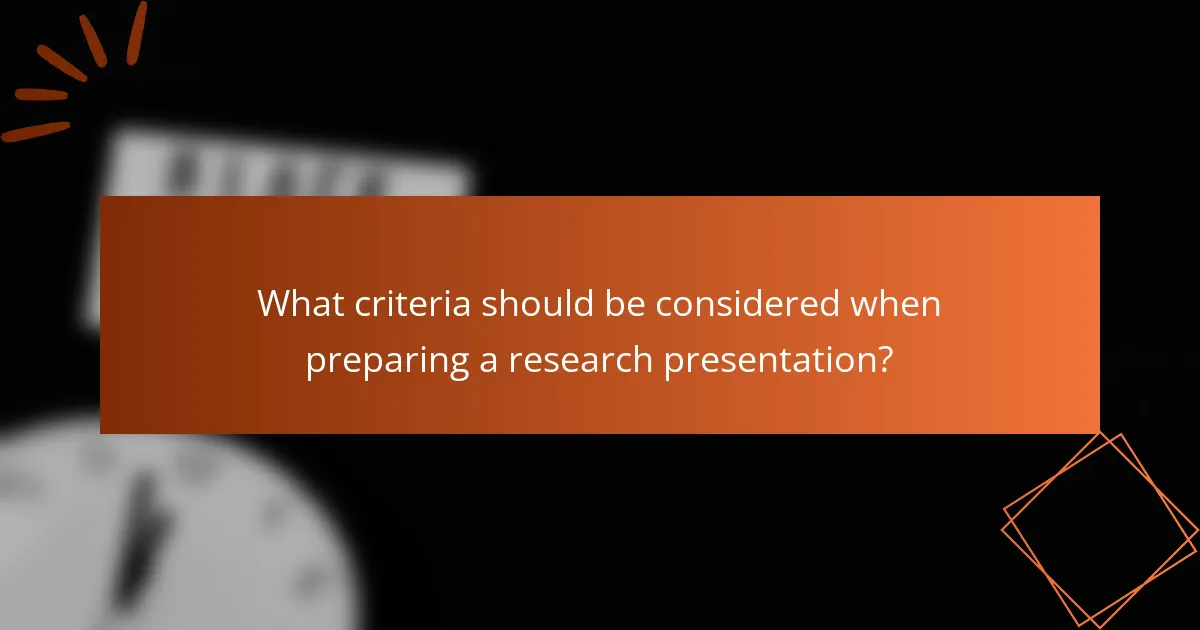
What criteria should be considered when preparing a research presentation?
When preparing a research presentation, it is essential to consider the audience’s background, the clarity of key messages, and the formats that best convey the information. These criteria ensure that the presentation is engaging, informative, and accessible to all participants.
Understanding the audience
Understanding the audience is crucial for tailoring the presentation effectively. Consider their expertise level, interests, and expectations to determine how to present complex information. For example, a presentation aimed at non-experts should avoid jargon and focus on fundamental concepts.
Engage the audience by asking questions or incorporating interactive elements. This approach can help gauge their understanding and adjust the presentation in real-time, making it more relevant and impactful.
Defining key messages
Defining key messages involves distilling the research findings into clear, concise statements that highlight the most important takeaways. Aim for two to four core messages that encapsulate the essence of the research. This clarity helps the audience retain information and understand its significance.
Use strong visuals or analogies to reinforce these key messages. For instance, a simple chart can effectively illustrate trends, while a relatable analogy can make complex ideas more digestible.
Choosing appropriate formats
Choosing the right formats for your presentation can significantly enhance comprehension. Consider using slides, handouts, or interactive tools based on the audience’s preferences and the nature of the content. For example, a mix of slides for visuals and handouts for detailed information can cater to different learning styles.
Additionally, ensure that the formats are accessible. For instance, if presenting in a multilingual setting, consider providing materials in multiple languages or using visual aids that transcend language barriers. This inclusivity can improve engagement and understanding across diverse audiences.

How to measure the effectiveness of research presentations?
Measuring the effectiveness of research presentations involves assessing how well the content resonates with the audience and achieves its intended goals. Key methods include gathering audience feedback, analyzing engagement metrics, and facilitating follow-up discussions.
Audience feedback surveys
Audience feedback surveys are a direct way to gauge the effectiveness of a presentation. These surveys can include questions about clarity, relevance, and overall satisfaction, typically using a scale from 1 to 5 or 1 to 10.
To maximize response rates, distribute surveys immediately after the presentation while the experience is fresh. Consider using online tools like Google Forms or SurveyMonkey to streamline the process.
Engagement metrics
Engagement metrics provide quantitative data on how the audience interacts with the presentation. This can include tracking attendance rates, the duration of participation, and interactions such as questions asked or comments made.
Utilize tools like Zoom or webinar platforms that offer analytics features to collect this data. High engagement often correlates with effective presentations, so aim for metrics that indicate active participation, such as a 70% attendance rate or more than 50% of attendees asking questions.
Follow-up discussions
Follow-up discussions are essential for understanding the long-term impact of a presentation. These discussions can take place in person or through virtual meetings, allowing for deeper exploration of the topics presented.
Encourage participants to share their thoughts and insights after the presentation, which can reveal areas of confusion or interest. Aim for a follow-up session within a week to maintain relevance and capitalize on the initial engagement.
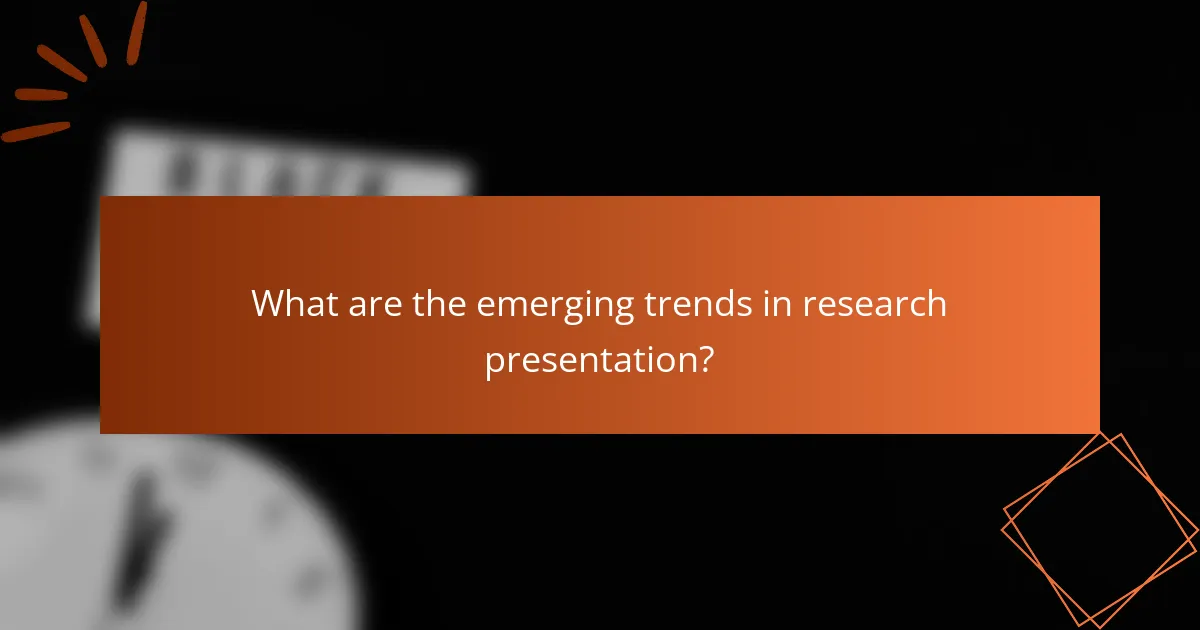
What are the emerging trends in research presentation?
Emerging trends in research presentation focus on enhancing clarity, engagement, and accessibility for diverse audiences. These trends emphasize visual storytelling, interactive elements, and simplified data representation to cater to both expert and non-expert stakeholders.
Visual Storytelling
Visual storytelling is becoming a cornerstone of effective research presentations. By integrating graphics, infographics, and videos, presenters can convey complex information in a more digestible format. This approach helps maintain audience interest and improves retention of key messages.
When utilizing visual storytelling, consider the balance between text and visuals. Aim for a ratio where visuals dominate, allowing text to support rather than overwhelm. For example, using a chart to illustrate trends can be more impactful than a lengthy explanation.
Interactive Elements
Incorporating interactive elements into research presentations can significantly enhance audience engagement. Tools such as live polls, Q&A sessions, and clickable content encourage participation and foster a sense of involvement. This approach is particularly effective in virtual settings where audience interaction may be limited.
To implement interactivity, choose platforms that support these features and prepare content that invites questions or feedback. For instance, using a polling tool during a presentation can gauge audience understanding and adjust the discussion accordingly.
Simplified Data Representation
Simplified data representation is crucial for making research findings accessible to non-experts. This involves distilling complex datasets into clear, concise visuals that highlight key insights without overwhelming the audience. Techniques such as using color coding and clear labeling can enhance comprehension.
When presenting data, focus on the most relevant figures and use summary statistics to convey the overall message. For example, instead of presenting raw data, summarize findings with a few key percentages or trends that capture the essence of the research.
